
NIVOGO’S SMART PRICING TECHNOLOGY
June 26, 2024
NEW CLASSIC SUSTAINABILITY
June 26, 2024Alongside sustainability, one of the most talked-about topics in fashion is “Circularity”. Industry professionals see circular business models as the future of fashion. Brands are embracing circular fashion movements to revamp their operations and establish new communication channels with consumers focused on the environment and humanity.
As a venture that transforms linear business models of giving brands a chance into circular ones, we want to share both the problems that motivate us to work on this issue and the basics of circular fashion with you.
Firstly, what is circular fashion?
At its core, circular fashion refers to a system where clothing items are produced with a more thoughtful approach, where the production and end of a product are equally important. In this cycle, the brand has basic human and environmental sensitivity within the framework of the materials and production methods it uses. Circular fashion emphasizes the value of using a product to its fullest, then taking it a step further by reusing it for another purpose, and ultimately recycling it. The focus is on the longevity and lifecycle of the things we own, including waste management, as a response to linear business models that have evolved into environmental, economic, and social devastations, such as “Produce-Consume-Discard”.
Why is there a need for Circular Fashion?
The term “Circular Fashion” was first used in 2014 at a seminar in Sweden focusing on sustainable fashion. It was a time when the world’s attention was turned to the fashion industry, as just a year earlier, a textile workshop had collapsed in Rana Plaza, Bangladesh, resulting in a tragic event where over 1000 workers lost their lives. It had become inevitable for consumers, producers, and brands to confront the severe consequences of fast fashion. The overwhelming production and labor practices dominating fashion had to change.
What is the role of brands, producers, and consumers in Circular Fashion?
Since 2014, movements supporting sustainability and circular systems in fashion have seen a steady rise in both brand and consumer awareness. The demand for good fashion from consumers shows brands that there is a better alternative for the environment and humanity.
Updating production and waste management processes to be environmentally friendly marks the first link in the chain of the circular fashion journey for brands. Brands that use sustainable materials, provide healthy working conditions for their employees, renew unsold products for consumers, and recycle products that cannot be renewed will be ahead as the brands of the future.
Producers providing resources for sustainable materials and production systems will also become one of the main actors in the changing fashion industry.
Consumer awareness of sustainable fashion is much higher now than just a few years ago, as detailed in our content “NEW TREND IN FASHION: Sustainability and Conscious Consumption”. The new consumer, who consumes less and prefers quality products that can be worn for many years, also plays a key role in the sustainability of this cycle by discarding their garments for recycling when their lifespan is complete.
At Nivogo, we are involved in both brand and consumer transformation during this transition.
We refurbish unfortunate products such as returns from brands or items worn or overstocked during display, transforming their linear business models into circular ones from a sustainability perspective. With our “Zero Waste System,” we also send products that cannot be renewed to recycling facilities. Through this cycle, we connect thousands of new clothing items, shoes, and bags with new owners instead of letting them end up in nature.
If you want to transform your business model into a circular one and take your brand into the future with a sustainable model, you can contact us.


